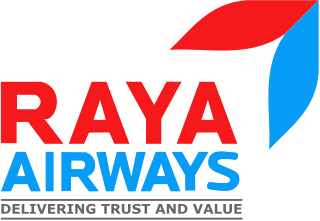
Kuala Lumpur International Airport (KLIA) is Malaysia's main international airport. It is located in the Sepang District of Selangor, approximately 45 kilometres (28 mi) south of Kuala Lumpur and serves the city's greater conurbation.
Malaysia Airlines Berhad, formerly known as Malaysian Airline System, and branded as Malaysia Airlines, is the flag carrier of Malaysia and a member of the Oneworld airline alliance. The company headquarters are at Kuala Lumpur International Airport. In August 2014, the Malaysian government's sovereign wealth fund Khazanah Nasional—which then owned 69.37% of the airline—announced its intention to purchase the remaining ownership from minority shareholders and delist the airline from Malaysia's stock exchange, thereby renationalising the airline. It operates primarily from its main hub Kuala Lumpur International Airport to destinations throughout Asia, Oceania and Europe, as well as its secondary hub Kota Kinabalu International Airport to Taipei and Tokyo (Narita).

Singapore Airlines is the flag carrier of the Republic of Singapore with its hub located at Changi Airport, and a member of the Star Alliance. The airline is notable for highlighting the Singapore Girl as its central figure in the corporate branding segment. Widely renowned as one of the best carriers, airline is ranked as a 5-star airline by Skytrax, and it has also been ranked as the world's best airline five times. The airline operates a variety of Boeing and Airbus aircraft, including the A350, 787, 777, A380, and 737.

Sultan Abdul Aziz Shah Airport, , often called Subang Airport or Subang Skypark, is an airport located in Subang, Petaling District, Selangor, Malaysia.
Jetstar Asia Airways Pte Ltd is a Singaporean low-cost airline headquartered at Changi Airport. It operates services to regional destinations in Southeast Asia to countries such as Myanmar, Cambodia, Malaysia, Indonesia, Philippines, Thailand and Vietnam. It also flies to regional routes in East Asia such as Japan, Taiwan and Hong Kong.
Malaysia–Singapore Airlines was the flag carrier of Malaysia and Singapore. It came into being in 1966 as a result of a joint ownership of the airline by the governments of the two countries. It was headquartered at Raffles Place in Singapore.

Raya Airways Sdn Bhd d/b/a Raya Airways, is a cargo airline with its head office in the Raya Airways Centre in the Cargo Complex of Sultan Abdul Aziz Shah Airport in Subang, Selangor, Malaysia.
Royal Air Force Kuala Lumpur or more simply RAF Kuala Lumpur is a former Royal Air Force (RAF) station in the Federation of Malaya and saw extensive use during the Malayan Emergency.
Aviation in Singapore is a key component of the Singaporean economy. Besides currently the sixth busiest airport and the fourth busiest air cargo hub in Asia, the Singaporean aviation industry is also a significant aerospace maintenance, repair and overhaul centre.

Kuching International Airport (KIA) is an international airport serving the entire southwestern region of Sarawak, Malaysia. It is located 11 km (6.8 mi) south of Kuching city centre. The airport is colocated with the RMAF Kuching, home to the No. 7 Squadron RMAF.

Kota Kinabalu International Airport (KKIA) is an international airport in Kota Kinabalu, the state capital of Sabah, Malaysia. It is located approximately 8 km (5.0 mi) southwest of the city centre. In 2019, over 9 million passengers passed through the airport, making it the second busiest airport in Malaysia after Kuala Lumpur International Airport in terms of passenger movements & aircraft movements and the third busiest in terms of cargo handled.

Firefly is a low-cost carrier subsidiary of Malaysia Airlines that offers flights within Malaysia, as well as to Indonesia, Singapore, and Thailand. Firefly operates from its main hub at Sultan Abdul Aziz Shah Airport in Subang and Penang International Airport, as well as its secondary hub at Kota Kinabalu International Airport. The airline's first flight was on 3 April 2007, from Penang to Kota Bharu. The company slogan is Beyond Convenience.
Pelangi Airways Sdn Bhd was a regional airline of Malaysia based at Kuala Lumpur Subang Airport. The airline covered secondary routes within Peninsular Malaysia and international flights to Sumatra in Indonesia, Thailand and Singapore.

Peninsular Malaysia, historically known as Malaya, also known as West Malaysia or the Malaysian Peninsula, is the part of Malaysia that occupies the southern half of the Malay Peninsula in Southeast Asia and the nearby islands. Its area totals approximately 132,490 km2 (51,150 sq mi), which is nearly 40% of the total area of the country; the other 60% is in East Malaysia on the island of Borneo.

Scoot Pte Ltd, operating as Scoot, is a Singaporean low-cost airline and a wholly owned subsidiary of Singapore Airlines. It began its operations on 4 June 2012 on medium and long-haul routes from Singapore, predominantly to various airports throughout the Asia-Pacific region. Scoot's airline slogan is Escape the Ordinary.
Batik Air Malaysia is a Malaysian full service carrier, an associate carrier of the Indonesian Lion Air Group, with headquarters in Petaling Jaya, Selangor, Malaysia. The original name, Malindo, signifies a cooperative pact between Malaysia and Indonesia.

This article explores the history of Singapore Airlines, the flag carrier of the Republic of Singapore and based at the Singapore Changi Airport. Singapore Airlines, also known by its abbreviations of SIA or SQ, has often been ranked throughout its history as either amongst the best or the best airline in the world.
Borneo Airways Limited also known as Borneo Airways, was the flag carrier and the principal domestic airline in British Borneo based in Labuan between 1957 until 1 April 1965 when it merged with Malaysian Airways.
MYAirline was a Malaysian low-cost airline founded in 2021. It was headquartered in Subang Jaya, Selangor and primarily operated from KLIA2, the low-cost carrier terminal of KLIA. The airline began its maiden flight on 1 December 2022 to Kuching International Airport. The company slogan was Your Experience Matters.












